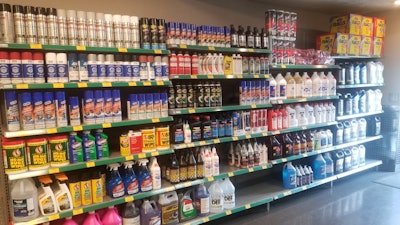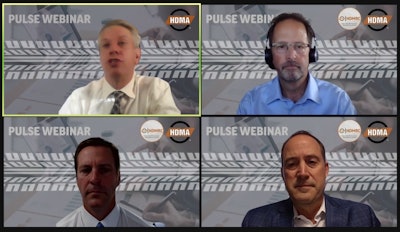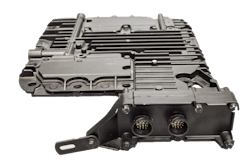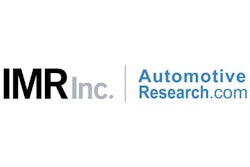
The supply and labor challenges, among others, continue to make life difficult for the trucking industry, according to Wednesday’s Heavy Duty Manufacturers Association (HDMA) Pulse Webinar.
Joining Richard Anderson, director of Market Research & Analysis, HDMA, on the webinar were members of the Heavy-Duty Manufacturers Representatives Council (HDMRC): Don Gritzmacher, president of Enders and Associates Inc., John Adami, principal at Northwest Heavy Duty Inc., and Bob Shimp, principal at William Shimp Sales Inc.
Though the Pulse webinars are typically data heavy, Anderson said this one would center around comments from Pulse respondents as well as those canvassed during field studies by the HDMRC.
Supply constraints
One of the Pulse survey responses stated that “forecasting schedules are no longer valid inputs to run a business. It has become reactionary.”
Anderson said, “We’ve seen over the past 18 months the difficulty suppliers have had with forecast accuracy and demand and this comment shows the longer-term impact [supply constraints] have had. Right now business is not being run normally. Suppliers now cannot meet demand. Thus the market no longer functions as before. If you have demand, it doesn’t mean the supply exists to fill it.”
Survey respondents also stated how difficult it is to explain the supply issue with its customers and how communication up- and downstream is key.
“It is very difficult for our members to communicate a situation that is so highly variable for themselves. The ability to give an answer on when something will arrive to a customer depends on your own supply chain and when that supply chain is in disarray, the ability to pass information that is accurate and timely just doesn’t exist,” Anderson said.
Shimp said respondents weighed in on what parts suppliers can do better. “I love this question … this is really the voice of the customers telling their suppliers where they need help,” he said.
 Richard Anderson, director of Market Research & Analysis, HDMA (clockwise); John Adami, principal at Northwest Heavy Duty Inc.; Don Gritzmacher, president, Enders and Associates, Inc.; and Bob Shimp, principal, William Shimp Sales Inc.
Richard Anderson, director of Market Research & Analysis, HDMA (clockwise); John Adami, principal at Northwest Heavy Duty Inc.; Don Gritzmacher, president, Enders and Associates, Inc.; and Bob Shimp, principal, William Shimp Sales Inc.
“As you look at the communication piece of this … it’s telling us that perhaps as suppliers, we’re not meeting the expectations of our customers. Our customers look at us as their partners and so it’s really important to address the expectation of our customer by explaining and making sure they know what’s going on at the supplier level,” Shimp said.
Gritzmacher said parts shortages being top of respondents’ minds should not be a shock or revelation.
“Clearly across the spectrum — no matter who we talked to in our customer base — people have definitely realized we have moved from the demand driven market to a supply driven market. What that supply driven market has forced people to do in some cases is begin to hoard products,” he said.
“I heard about customers placing orders [up] to four times more in terms of their normal consumption. There’s really a couple reasons why people are doing that,” Gritzmacher said. “First of all, there’s a lack of confidence in how our supply chain is going to get fixed and, secondly, it’s an inflationary catch. Folks believe pricing volatility is going to remain for a while and this is way to essentially create an investment in their business.”
Pricing volatility is another top concern and the current escalation in pricing and how it’s changing buying habits in order to get product in the door.
“We had a couple fleets comment their primary sources were independent distribution for parts and components and that they had experienced enough volatility in pricing with their traditional sourcing, it forced them to look at other channels of supply,” Gritzmacher said. “Several [survey respondents] commented they were surprised to see the OEM dealers arising as a very competitive alternative to independent distribution.”
Labor shortage
Survey participants also were asked what they foresee in the next 18 months regarding the most significant change coming in the commercial vehicle market.
“What we heard a lot about was labor issues. The labor market is limited and we’re having difficulty hiring. One supplier said, ‘I’m not even sure when I will see anything different happening in the next 18 months to change that,’” Anderson said.
“Not only have labor issues not improved in the short term, but suppliers are also not seeing any relief on the horizon. The ability to fix the inventory problem hinges upon the availability [of employees] and worker shortages are causing additional supply chain problems … for our members,” he added.
Businesses are having trouble finding talent and working harder to retain talent and are having to get creative when dealing with the labor market, which means, in many instances, higher pay and additional benefits, Gritzmacher said.
While the labor market continues to be an issue during the pandemic, Adami said it’s always been an issue for the trucking industry — long before COVID-19 and related challenges arrived.
“Once again it’s a painful extension of what has been going on for the past 18 months or is it? Has there ever been a time in our industry when we’ve had enough technicians or drivers? Not really. It’s chronic and part of our [industry] DNA,” he said.
Along labor lines, Anderson polled Pulse Webinar attendees on Wednesday asking “How would you rate your general staff morale?”
While 34 percent of respondents reported morale is normal and another 3 percent stating morale is higher than normal, 45 percent reported morale needs “some” or “significant” improvement.
“That means half of our audience has what they would probably consider a morale problem,” Anderson said. “This is yet another pressure that will continue mounting on suppliers and the entirety of the economy.”
What might be the worst aspect of all these hurdles for the industry is the unknown.
“We don’t know how long it’s going to last. We don’t know how long these issues are going to persist with parts, [shipping] containers, COVID, computer chips — I don’t know, you don’t know,” Adami said.










